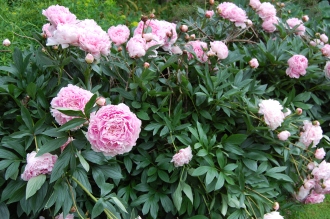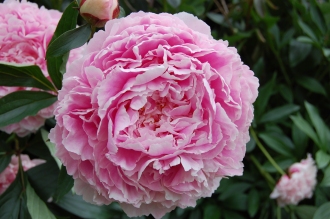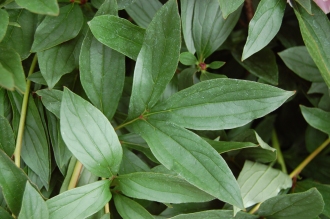Position: Full sun to partial shade
Flowering period: Early summer
Soil: Moist, well drained
Eventual Height: 70cm
Eventual Spread: 70cm
Hardiness: 3a, 3b, 4a, 4b, 5a, 5b, 6a, 6b, 7a, 7b, 8a, 8b, 9a
Family: Paeoniaceae
Paeonia lactiflora ‘Sarah Bernhardt’ is a large flowered deciduous herbaceous perennial. Its dark green leaves are divided into up to nine lanceolate leaflets and up to 40cm long. Its stems are erect and arching. Its fragrant pink flowers are double, appear in the leaf axis terminally and are up to 20cm across. Its roots are tuberous.
The species Paeonia lactiflora, commonly known as the Chinese Peony or Common Garden Peony, is native to east Tibet, north China and east Siberia.
The etymological root of the binomial name Paeonia is named after Paeon, a Greek physician of the gods who, in mythology, was changed into a flower by Pluto. Lactiflora is derived from the Latin lactis meaning ‘milk’ and flora ‘the goddess of flowers’, in reference to the species having white flower.
The landscape architect may find Paeonia lactiflora ‘Sarah Bernhardt’ useful as part of a herbaceous planting scheme with its attractive large fragrant flowers. This perennial is not attractive to deer or rabbits.
Ecologically, Paeonia lactiflora ‘Sarah Bernhardt’ flowers are attractive to pollinating insects.
The Royal Horticultural Society has given the variety Paeonia lactiflora ‘Sarah Bernhardt’ their prestigious Award of Garden Merit in 1993.
Paeonia lactiflora ‘Sarah Bernhardt’ prefers moist, deep, humus rich, well-drained soils. It tolerates most pH of soil. It will not tolerate dry soils.
Paeonia lactiflora ‘Sarah Bernhardt’ requires little maintenance. Once planted the roots of this plant should not be disturbed.








Leave a comment